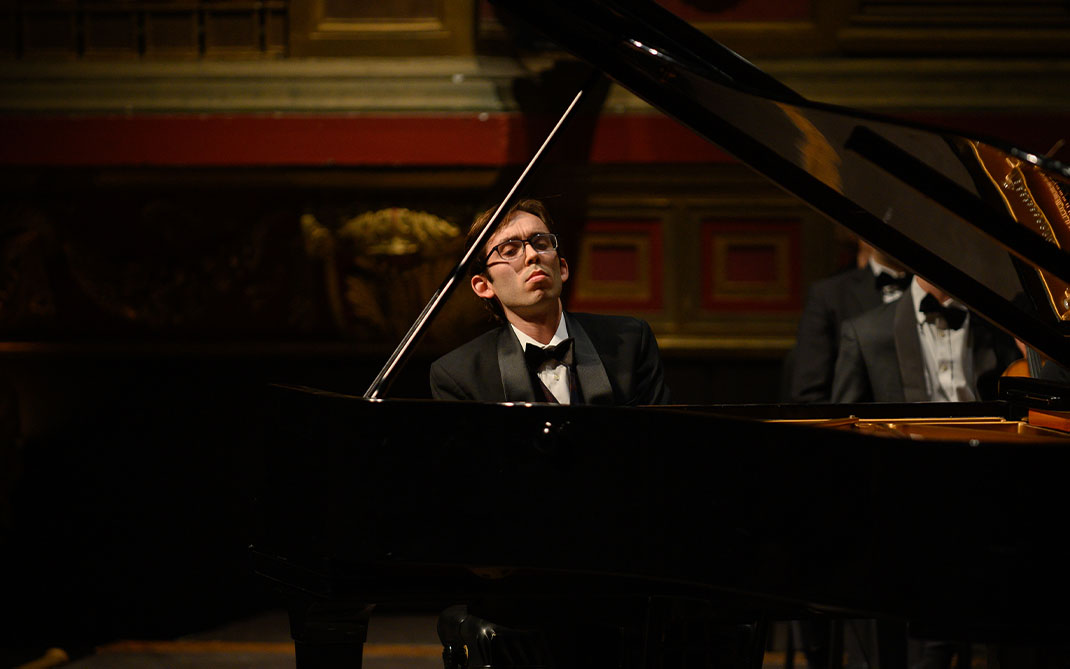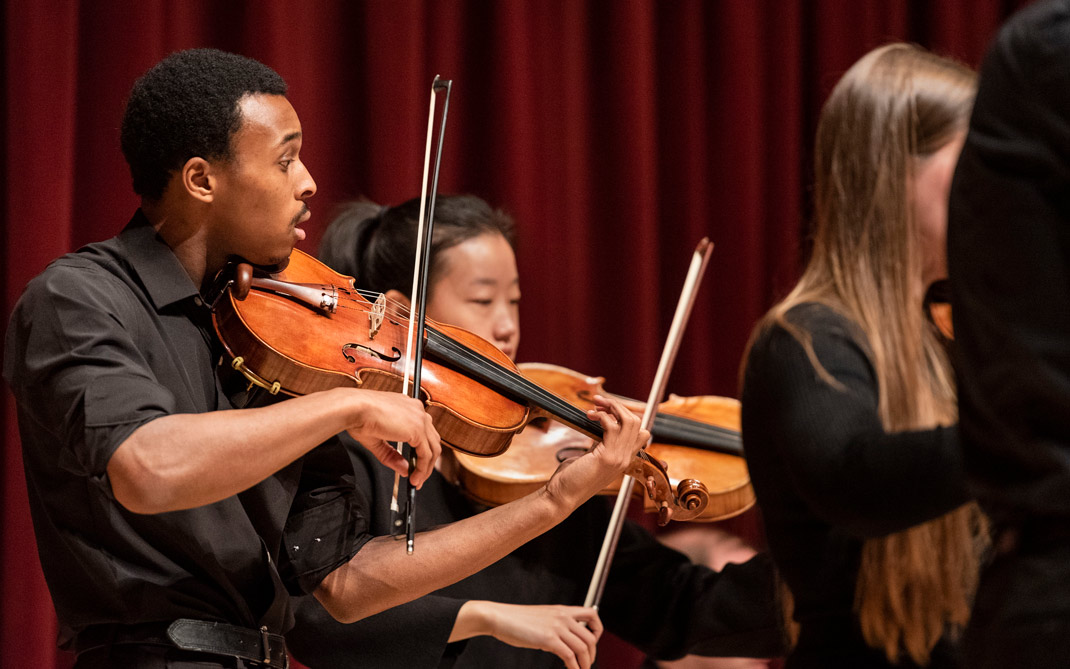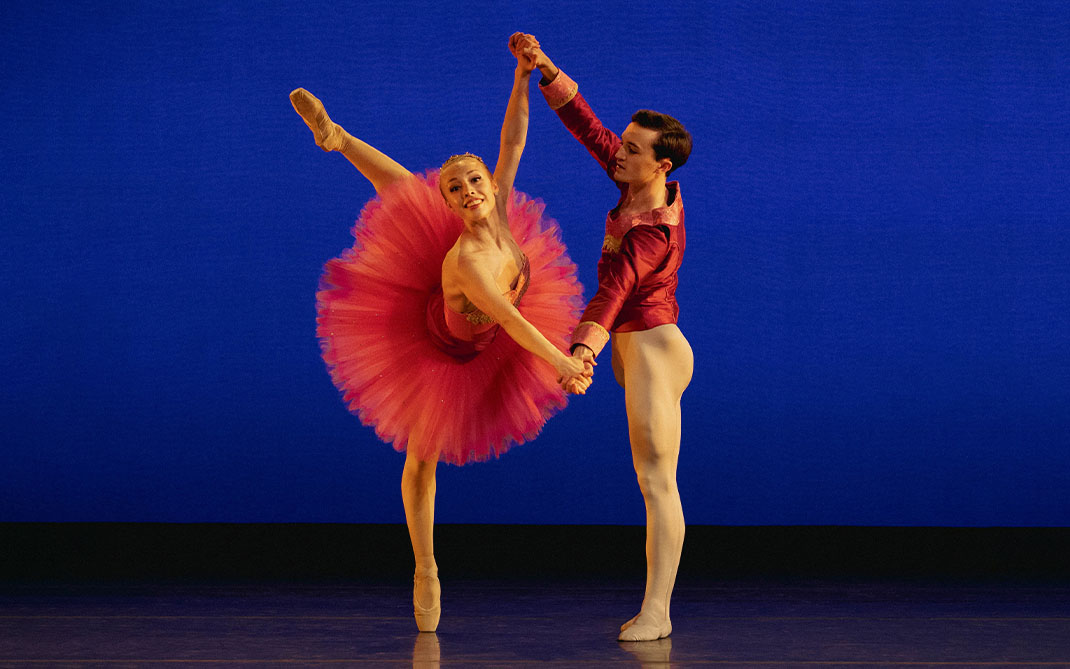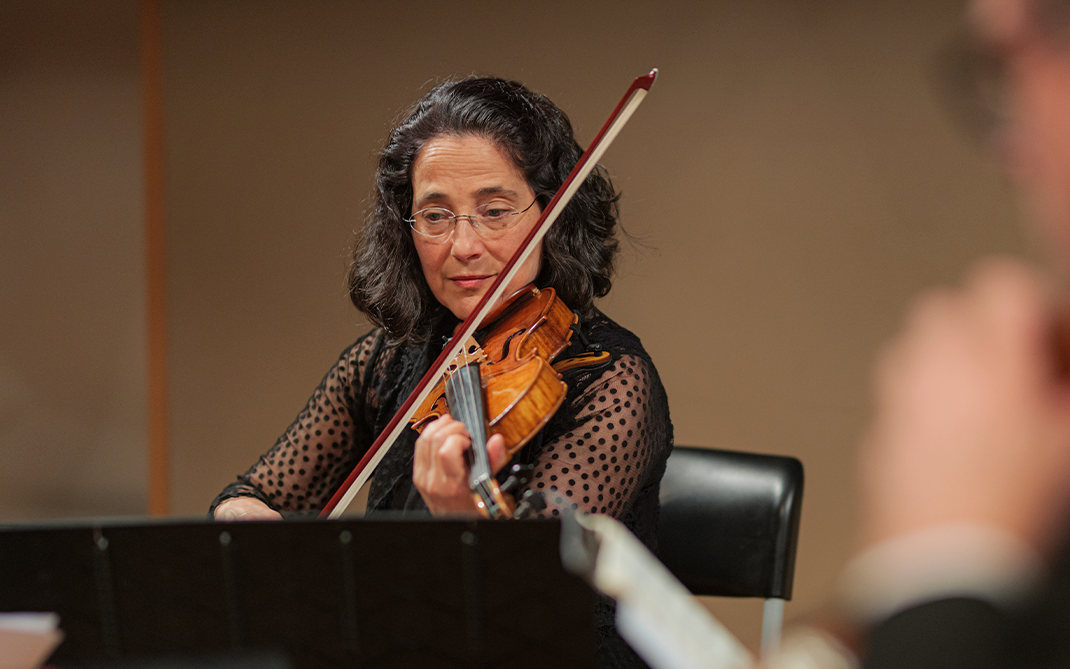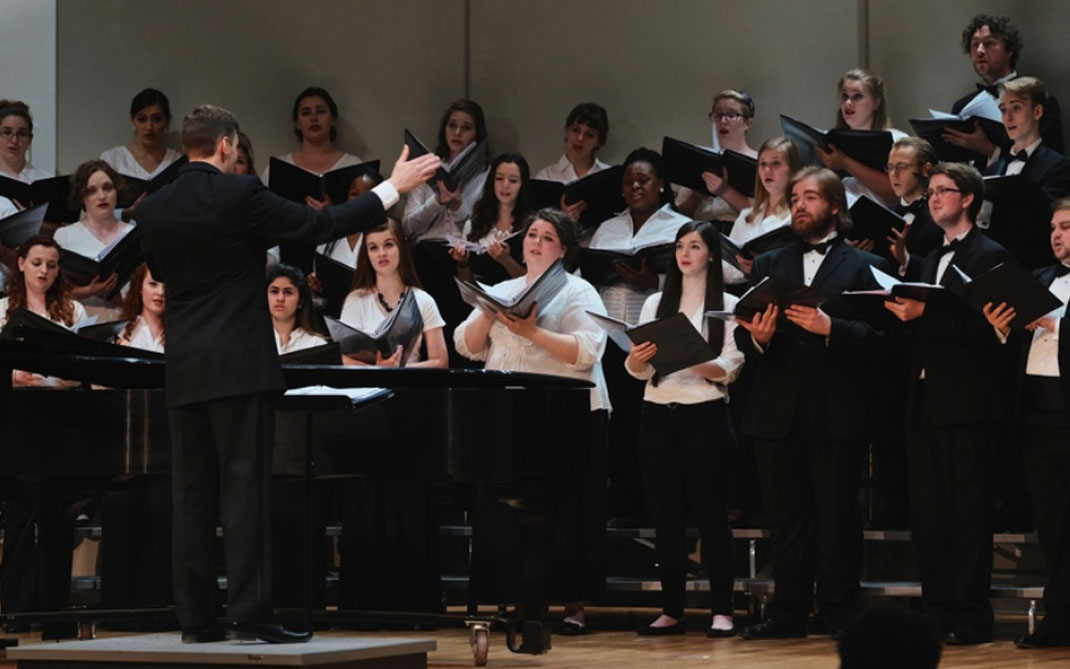School of Drama Annual Report
Drama
The following Student Learning Objectives and assessment information is for Bachelor of Fine Arts undergraduate programs in the School of Drama. Concentrations are offered in Acting and Directing.
Program Mission
The School of Drama at the University of North Carolina School of the Arts trains talented young men and women to be exciting, versatile and accomplished professionals. The school emphasizes classical values in its training to meet a well-recognized demand for actors to be technically skilled and, at the same time, creatively inspired. This vital combination of talent and skill is developed and refined by a highly qualified professional faculty through close, personal attention to their students’ growth.
Student Learning Objectives (SLOs)
SLO 1. Creating a Role
By the end of Spring Semester of their third year of training, students will demonstrate the ability to creatively transform into character, through the application of craft skills learned, including physical and vocal control. Students will be able to articulate that transformational process through the use of craft terms.
Assessment Plans and Activities
Measure 1
Faculty evaluations in relevant classes, Studios 1-3
Measure 2
Student post-show discussion after fall term Studio 3 shows
Measure 3
Dean & faculty rehearsal & performance critiques
Evidence of Student Learning
In 2015-2016, the progress was largely evaluated using our faculty evaluations, which are conducted every seven weeks as an overview of the individual progress of each student. Work in all classes is considered; for the purpose of SLO 1 we are discussing data relevant to acting, voice, speech, and movement classes, as individual students seek to create roles, especially in acting classes, Studio 2 in-class presentations, and in Studio 3 mainstage performance opportunities.
Faculty observed strong progress in voice and speech amongst all three grade levels, with Studio 3 having an especially demanding season of vocal work that included a spring show in Scottish dialect and another the lyrical poetry of August Wilson. Movement flexibility was also much prized in our mainstage season, especially in the fall’s GOOD (with great amounts of mime) and BLACK WATCH (with huge amounts of choreography and detailed physical work). The acting work across the studio 2 presentations was strong, although some students struggled with personalization and making consistently high-stakes choices in the moment. In Studio 3, there was strong work although the spring period comedy (THE WOMEN) featured less grounded performances than we’d prefer, with a few caricatures filling the space with less truth than is preferable from actors at that level.
Interpretation
Often, we find that comedy is more challenging than any other genre, particularly
in work with a more substantially language driven vehicle; as such, the struggles
of our productions of THE WOMEN and to a lesser degree ARCADIA are expected. It suggests
that programming those plays comes perhaps with a slightly higher degree of difficulty
and expected level of success. Providing challenges in dialects, especially in spring
of third year production experience (after the speech & dialect curriculum is significantly
progressed) is a useful and important challenge, as was the case this year. Strong
physical preparation let our students attempt some demanding physical roles, and plays
that demand strong physical choices help further that classroom work into our production
season.
Use of Student Learning Evidence
Plays in the production program are chosen, especially in third year, with an eye toward challenging and engaging students, and difficult literature presents the risk of failure. The Dean will continue to consult with faculty to continue to seek out titles that present appropriate training-based challenges in speech, accents, acting, style, and physicality. In the coming year, we have a season planned that includes many challenges in third year, but again only one comedy and that is in the last possible slot when they have as much experience as possible. Continuing to have faculty and guest artists focused on truth over style to achieve style without sacrificing authenticity is an ongoing goal of the program.
NOTE: The Drama School, as a result of the SACS ten-year review in 2015-2016, is adopting a new faculty evaluation form. Previously, it was a one-page document, with a numerical index for Mind, Body, and Spirit, the three ways of learning; however, there was no standardized rubric for these measures and they were shared with students, which encouraged generosity. The new evaluation forms will have a student-shared half that is all written; this half will be shared with the faculty at evaluation times. The second half, for faculty only, will be a newly-rubriced scale for these three SLOs, and will be scored only for classes that correspond to the SLO in question. We’ll develop those rubrics this summer and begin tracking those results next fall.
SLO 2. Text Interpretation
By the end of the second year of training, students will show an ability to creatively interpret acting texts, and make choices for performance based on an understanding of character, style, theme, and dramatic structure. This work culminates in the second year Shakespeare projects, in which students must demonstrate an ability to understand and interpret classical text. (Note: This is a new SLO as designated after feedback from our most recent SACS accreditation visit.)
Assessment Plans and Activities
Measure 1
Dean & Faculty Critiques of Studio 2 Shakespeare Projects
Measure 2
Faculty Evaluations of Studio 1 & 2 Acting classes
Evidence of Student Learning
Studio 2 Shakespeare projects are the culmination of this work, and here there was strong work across the two sections this spring. Half the class worked on OTHELLO, and it represented the most complicated text rendered clearly, with excellent stakes, high levels of interpretive control, and clear choices throughout. Especially notable is the clarity of arc within the Emilia storyline, indicative of a particularly carefully wrought piece of textual interpretation. In the second half, MUCH ADO ABOUT NOTHING was perhaps less successful in places, with some characters falling occasionally into archetype. While Leonato and the Duke were notable exceptions to this tendency, a few of the leading players indicated sometimes where more restraint might reveal more textual nuance. Overall, these presentations showed a class that has progressed in their ability to render text with high stakes and make clear, actable choices.
A new teacher in Studio 1 text interpretation class provides a new benchmark for progress in the first year of this class, and will adopt a new rubric for evaluation next year; this year, he found varying levels of reading comprehension a challenge in the work as actors engaged new text for the first time using acting vocabulary.
Interpretation
A generally strong showing from Studio 2 this year is the result of two new faculty
members highly engaged in a careful reading of the text who used the long rehearsal
period in a focused way to realize strong choices; MUCH ADO was a new faculty member’s
first attempt at this in-class project, and the experience helped him better understand
the goals and demands of this work. Both groups benefited from the long process. The
new teacher was also leading Studio 1’s text analysis class, and found varying degrees
of comfort in reading comprehension a challenge; students in this class are attempting
to incorporate two other acting classes as well as new voice work in the space for
the first time, and often this process is a challenge of a lot of integration in a
short time period.
Use of Student Learning Evidence
The Studio 1 text class was previously taught in spring only. In 2016-2017, we have made it a year-long class, with the fall focused exclusively on text at the table (what in the theater we call “table work”). The hope is that the added time allows the Studio 1 text teacher additional time and angles to help students realize how to read and interpret a play as an actor, finding actable choices that ignite their imagination in the space with a variety of texts with various challenges.
NOTE: The Drama School, as a result of the SACS ten-year review in 2015-2016, is adopting a new faculty evaluation form. Previously, it was a one-page document, with a numerical index for Mind, Body, and Spirit, the three ways of learning; however, there was no standardized rubric for these measures and they were shared with students, which encouraged generosity. The new evaluation forms will have a student-shared half that is all written; this half will be shared with the faculty at evaluation times. The second half, for faculty only, will be a newly-rubriced scale for these three SLOs, and will be scored only for classes that correspond to the SLO in question. We’ll develop those rubrics this summer and begin tracking those results next fall.
SLO 3. Professional Preparedness
By the end of the fourth year of training, students will have acquired, and be able to demonstrate, the necessary collaborative skills to work effectively on a professional level in studio and performance projects with directors, fellow actors, stage managers, designers, technicians, and all parties who participate in the process of bringing a production to realization. Professional preparedness includes the rehearsal and execution of the acting showcase in New York & Los Angeles and subsequent industry introductions, with the goal of securing representation and connecting to the relevant industry.
Assessment Plans and Activities
Measure 1
Dean & Faculty Evaluations of Rehearsal & Performance
Measure 2
Agent & manager Signings/Feedback at NY & LA Showcase
Evidence of Student Learning
Studio 4 had a somewhat successful season on the mainstage; as a class, their levels of professionalism were largely excellent. Relations with designers and other actors were generally cordial and supportive by professional standards, and rehearsal preparation was adequate. Fall shows were somewhat hampered perhaps by under-preparedness, something which was much better in spring. Of the 6 shows principally cast with Studio 4 actors, three enjoyed success, one had mixed results, while two struggled somewhat in final execution. The musicals DROWSY CHAPERONE and NINE were particularly effective, and the dramas JOE TURNER and ARCADIA had more success than the comedy (WOMEN, a mixed St. 3 and 4 production) and the Shakespeare, PERICLES. Additionally they produced and performed the KEYS TO THE KINGDOM independent season of 7 plays, where the quality of work varied significantly, although there were significant highlights including STARY DOG STORY and SEMINAR featuring some of the student’s best work.
At showcase, this class acquitted themselves admirably. 15 of 22 seniors signed with an agent or manager at showcase, a four-year high for the Drama Conservatory. Everyone in the class had at least one meeting in New York or La, and half the class had ten or more meetings between the two markets.
Interpretation
Studio 4’s seasonal successes and failures are in part time-bound; the class also
prepared and presented an independent season of 7 plays, and the considerable challenges
of preparing and presenting 13 shows by the 22-actor class were manifest sometimes
in the work being spread too thin; ARCADIA (first up in fall) and PERICLES (last in
spring) for example both were under a lot of pressure against other projects and exigencies
(including summer break, where preparation is concerned). The seniors were well prepared
to work as an ensemble, and their success in mounting independent work came from the
most fruitful collaborations, spaces where student directors and actors had the most
positive and productive exchanges. In spring term, we instituted a policy of arriving
to first rehearsal with all lines memorized, which seemed to have a salutary effect
on Studio 4s preparedness.
The significant success of Studio 4 at showcase is attributable, we believe to a few factors: the number of professional guests increased this year, up to 15 (eight who had been to campus before, seven new guests). Showcase has been directed/led by a consistent style and team for four years now, building trust and confidence in the industry, and all the coordinating/scheduling/ marketing was handled highly proficiently. 15 of 22 is an incredible return in an industry where 8% if union actors have representation; it is a high-water mark for the program.
At showcase, this class acquitted themselves admirably. 15 of 22 seniors signed with an agent or manager at showcase, a four-year high for the Drama Conservatory. Everyone in the class had at least one meeting in New York or La, and half the class had ten or more meetings between the two markets.
Use of Student Learning Evidence
In 2016-2017, we’ll ask seniors to arrive at rehearsals with all lines memorized for all shows; the idea was suggested by Tony-winning director Joe Mantello, and we’re interested to see if students can provide that level of preparedness without “locking” choices before rehearsal starts. The goal is to provide a wider range of choices, not narrower, and it requires discipline (doing a lot of work on your own) and flexibility (to change approach even after a lot of work outside rehearsal) to succeed. We’ll continue to bring guests, and will attempt to continue to connect the department to new agents & managers while maintaining many previous relationships. A 50/50 balance of old and new guests might be hard, but we’ll strive to have at least 30% of our guests be first timers, to continue our outreach to the industry.
NOTE: The Drama School, as a result of the SACS ten-year review in 2015-2016, is adopting a new faculty evaluation form. Previously, it was a one-page document, with a numerical index for Mind, Body, and Spirit, the three ways of learning; however, there was no standardized rubric for these measures and they were shared with students, which encouraged generosity. The new evaluation forms will have a student-shared half that is all written; this half will be shared with the faculty at evaluation times. The second half, for faculty only, will be a newly-rubriced scale for these three SLOs, and will be scored only for classes that correspond to the SLO in question. We’ll develop those rubrics this summer and begin tracking those results next fall.
